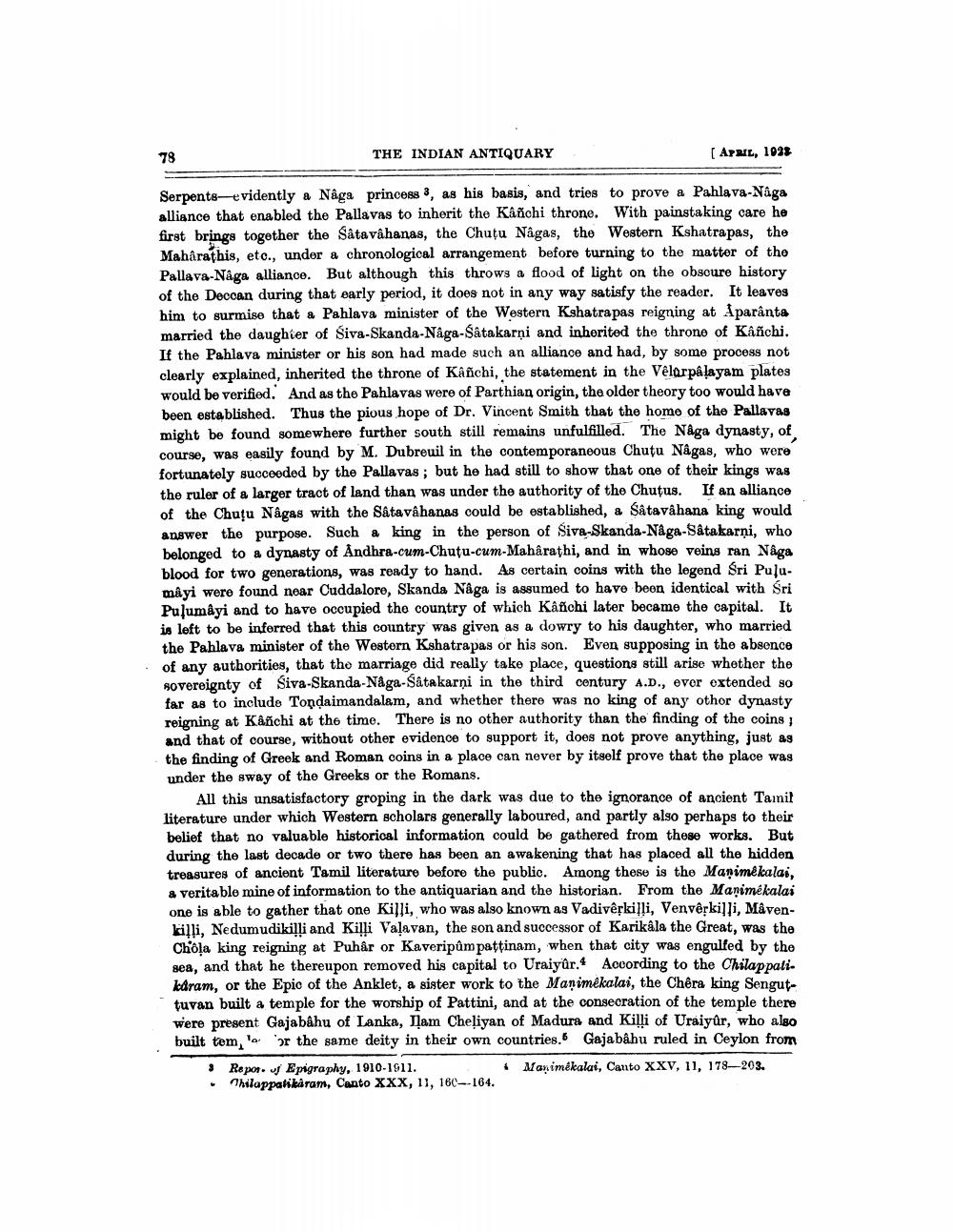________________
THE INDIAN ANTIQUARY
[ Arat, 1025
Serpents-evidently a Nâga princess 3, as his basis, and tries to prove a Pahlava-Naga alliance that enabled the Pallavas to inherit the Kanohi throne. With painstaking care he first brings together the Satavahanas, the Chuţu Nâgas, the Western Kshatrapas, the Mahârathis, etc., under a chronological arrangement before turning to the matter of the Pallava-Naga alliance. But although this throws a flood of light on the obsoure history of the Deccan during that early period, it does not in any way satisfy the reader. It leaves him to surmise that a Pahlava minister of the Western Kshatrapas reigning at Aparanta married the daughter of Siva-Skanda-Naga-Satakarņi and inherited the throne of Kanchi. If the Pahlava minister or his son had made such an alliance and had, by some process not clearly explained, inherited the throne of Kâñchi, the statement in the Vélarpalayam plates would be verified. And as the Pahlavas were of Parthian origin, the older theory too would have been established. Thus the pious hope of Dr. Vincent Smith that the home of the Pallavas might be found somewhere further south still remains unfulfilled. The Någa dynasty, of course, was easily found by M. Dubreuil in the contemporaneous Chutu Någas, who were fortunately succeeded by the Pallavas; but he had still to show that one of their kings was the ruler of a larger tract of land than was under the authority of the Chutus. If an alliance of the Chuţu Nâgas with the Satavahanas could be established, a Satavahana king would answer the purpose. Such a king in the person of Siva-Skanda-Nâga-Satakarni, who belonged to a dynasty of Andhra-cum-Chutu-cum-Mahârathi, and in whose veins ran Naga blood for two generations, was ready to hand. As certain coins with the legend Sri Pulumâyi were found near Cuddalore, Skanda Naga is assumed to have been identical with Sri Puļumâyi and to have occupied the country of which Kafichi later became the capital. It is left to be inferred that this country was given as a dowry to his daughter, who married the Pahlava minister of the Western Kshatrapas or his son. Even supposing in the absence of any authorities, that the marriage did really take place, questions still arise whether the sovereignty of Siva-Skanda-Någa-Satakarni in the third century A.D., ever extended so far as to include Tondaimandalam, and whether there was no king of any other dynasty reigning at Kâñchi at the time. There is no other authority than the finding of the coins ; and that of course, without other evidence to support it, does not prove anything, just as the finding of Greek and Roman coins in a place can never by itself prove that the place was under the way of the Greeks or the Romans.
All this unsatisfactory groping in the dark was due to the ignorance of ancient Tainit literature under which Western scholars generally laboured, and partly also perhaps to their belief that no valuable historical information could be gathered from these works. But during the last decade or two there has been an awakening that has placed all the hidden treasures of ancient Tamil literature before the public. Among these is the Manimekalai, a veritable mine of information to the antiquarian and the historian. From the Manimekalai one is able to gather that one kisli, who was also known as Vadivêşkilli, Venvêşkilli, Mâvenkilli, Nedumudikilli and Killi Valavan, the son and successor of Karikala the Great, was the Chola king reigning at Puhår or Kaveripům pattinam, when that city was engulfed by the sea, and that he thereupon removed his capital to Uraiyur. According to the Chilappali. karam, or the Epic of the Anklet, a sister work to the Manimekalai, the Chêra king Sengut. tuvan built a temple for the worship of Pattini, and at the consecration of the temple there were present Gajabâhu of Lanka, Jam Cheliyan of Madura and Killi of Uraiyûr, who also built tem, or the same deity in their own countries. Gajabahu ruled in Ceylon from 3 Repor. w Epigraphy, 1910-1911.
Manimekalai, Canto XXV, 11, 178-203. Chilappatikaram, Canto XXX, 11, 160--164.




